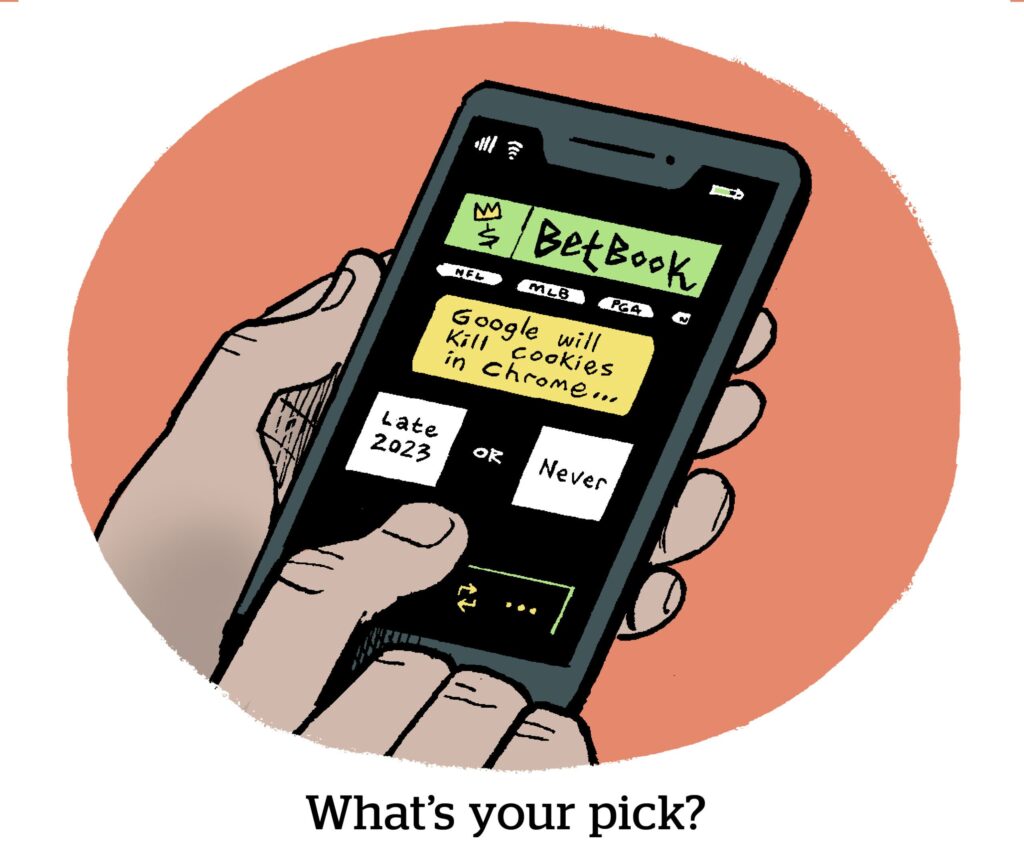When the Supreme Court overturned the federal ban on sports betting in 2018, the addressable audience for gambling companies grew massively.
People could start placing bets online and through apps. New Jersey became the first state to legalize online sports betting that year, and roughly 30 states have followed suit since, including Pennsylvania, Arizona, Colorado, Connecticut, Illinois, Indiana, Maryland, Michigan, Ohio and New York.
Publishers, brands, platforms and sportsbooks have also been striking deals on the regular, including partnerships between DraftKings and Amazon and between FanDuel and Kevin Garnett’s Gaming Society over the past month alone. (There are also rumors floating that DraftKings is on the cusp of a partnership with ESPN.)
But despite the online betting market cracking wide open, efficiently targeting potential gamblers has become, paradoxically, more difficult.
Speculation
When someone walks into a physical sportsbook, usually located inside a casino, it’s pretty obvious what their intentions are: They want to bet on a sporting event and usually a specific one. It’s a self-selected and highly motivated crowd.
But now that you can legally place bets online from anywhere, reaching the right people is tricky.
Even some of the most rabid sports fans will never place a bet in their lives. Following a team closely, reading sports sites on the daily and watching live games aren’t necessarily indicators a person will ever download a gambling app.
That doesn’t stop gambling companies from running contextual ads. It’s a no-brainer to hit people up with ads for sports betting when they’re reading about sports.
But that audience is going to include a lot of people who don’t and never will identify as a sports bettor, said Mike Smith, the US head of ad:s, which is a sport-focused marketing cloud of sorts, housed within Sportradar, a sports data provider. When gambling companies, sports publishers and professional sports leagues, including the NBA, NHL, MLB, Nascar, FanDuel and DraftKings want aggregate data on betting odds, live stats and historical sports-related info, they go to Sportradar.
Contextual “is just not the most efficient way to reach people who are interested in gambling,” Smith said.
Consider the makeup of the online gambling audience. “Depending on which study you read, somewhere between 90% and 95% of sports bettors are male,” Smith said.
 And gamblers remain a homogeneous crowd despite the fact that many women watch sports and consume sports-related content. For instance, the NFL said in 2020 that women make up 47% of its fan base.
And gamblers remain a homogeneous crowd despite the fact that many women watch sports and consume sports-related content. For instance, the NFL said in 2020 that women make up 47% of its fan base.
Although women have started using gambling apps at a higher rate over the past few years – female user rates grew 115% last year compared to 2020, according to data from Global Wireless Solutions – the fact remains that fewer women gamble than men overall.
And that means that despite more effort on the part of gambling companies to engage women in sports betting, “right now, a lot of the messaging isn’t relevant to around half the people seeing it,” Smith said.
Better bettor targeting
To get more strategic with their targeting while also broadening their audience, some online sportsbooks are making a bet on programmatic.
In 2019, a little less than a year after online sports betting was legalized at the federal level, Sportradar launched its ad:s platform, which has tools, including a homegrown DSP, that are specifically geared toward the needs of sports betting companies, including betting-specific targeting opportunities and campaign optimization.
The effort and expense of getting someone to download a betting app is only valuable if that person goes on to place bets, and engagement is just a different animal in the gambling world, Smith said.
Whereas, for example, a coffee brand may target people with ads just twice a day – in the morning and right before the mid-afternoon slump – a sports betting app has the opportunity to push people to place bets with way more frequency during a live game.
Someone who places multiple real-time bets on different aspects of a game (the point spread at halftime, say, or how much a specific player will score by the third quarter) is more likely to stay engaged in a gambling app than someone who places one bet at the beginning of a game and that’s it.
“Just imagine if you got a Starbucks ad or push notification every five minutes,” Smith said. “But gambling network operators can engage people with more frequency and velocity – as long as their messaging is relevant and can keep up.”
Playing for keeps
But acquiring, retaining and engaging online gamblers can be a challenge for a “generic demand-side platform,” said Veiko Poom, head of digital marketing at Coolbet, an online gambling and gaming company that operates in Canada, Estonia, Finland, Norway, Chile, Peru, Ecuador and Iceland.
Coolbet partnered with a generalist DSP several years ago. But as Coolbet looked to grow across channels and markets, and its customer acquisition goals increased, “we needed to make some changes and were unable to do that effectively,” Poom said.
In 2020, Coolbet partnered with ad:s, starting with programmatic test campaigns in Canada, which later expanded to campaigns across multiple markets.
Overall, Coolbet has seen a 60% reduction in its cost per acquisition tied to programmatic advertising and a 100% increase in net gaming revenue, which is the gambling industry term for revenue generated minus bonuses, free bets or other promotional costs.
Now, more than two years in, the relationship has evolved from campaign execution “into something more strategic,” Poom said. Coolbet even includes Sportradar in its programmatic media planning process.
“We work together to decide on campaign promotions – what to push, what not to push, what to prioritize – to achieve marketing success,” Poom said. “It’s highly targeted.”














